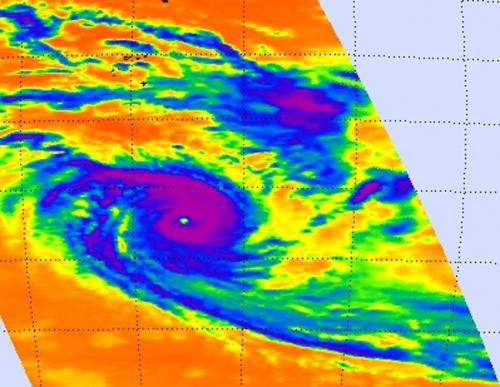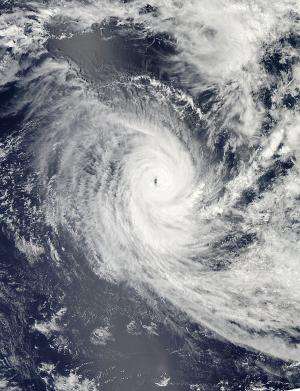On Dec. 10 at 0841 UTC (3:41 a.m. EST), NASA's Aqua satellite AIRS instrument captured this infrared view of Cyclone Claudia which showed a clear (cloud-free) eye surrounded by powerful thunderstorms (purple). Credit: NASA JPL, Ed Olsen
NASA's Aqua satellite got "eyeballed" from Cyclone Claudia in the Southern Indian Ocean when two instruments captured the storm's eye in infrared and visible light. Satellite data indicates that Claudia's eye is about 10 nautical miles wide.
On Dec. 10 at 0841 UTC (3:41 a.m. EST), NASA's Aqua satellite's Atmospheric Infrared Sounder (AIRS) instrument captured an infrared view of Cyclone Claudia which showed a clear eye surrounded by powerful thunderstorms. The thunderstorms that surrounded the eye were high in the troposphere and cloud top temperatures topped -63 Fahrenheit (-52 Celsius).
During that same overpass the Moderate Resolution Imaging Spectroradiometer (MODIS) instrument also aboard Aqua captured a stunning visible image of Claudia that clearly showed an eye.
NASA's Aqua satellite passed over Cyclone Claudia on Dec. 10 at 0850 UTC (3:50 a.m. EST/US) and captured this visible image of the storm using the MODIS instrument aboard. Credit: NASA Goddard MODIS Rapid Response Team
Claudia became a cyclone over the weekend of Dec. 8 and 9. On Dec. 8, Tropical Cyclone Claudia's winds increased to cyclone strength. During the early morning hours on Dec. 8 NASA's Tropical Rainfall Measuring Mission (TRMM) satellite passed overhead and identified that the heaviest rainfall lay south of the eye of the storm. Rain in that quadrant of the storm was falling at a rate of 30 millimeters (1.2 inches) per hour.
On Sat. Dec. 8, Claudia's maximum sustained winds were near 100 knots (115 mph/185 kph). Claudia was a category 3 cyclone and considered a major storm. It was centered near 14.7 south latitude and 74.6 east longitude, or about 450 nautical miles south-southeast of Diego Garcia. Claudia was moving to the southwest at 4 knots (5 mph).
On Monday, Dec. 10, Cyclone Claudia's maximum sustained winds increased to 105 knots (121 mph/194.5 kph). Claudia had moved about 175 nautical miles in two days and was centered near 18.0 south latitude and 73.8 east longitude, about 625 nautical miles south of Diego Garcia. Claudia continues to move southward at 7 knots (8 mph/13 kph) over open ocean.
Claudia is moving southward along the western edge of ridge (elongated area) of high pressure, and is expected to speed up and turn toward the southeast according to the forecasters at the Joint Typhoon Warning Center.
Claudia may not be giving any NASA satellite the "eye" after another day or two when it runs into cool waters and an area of stronger vertical wind shear.
Provided by NASA's Goddard Space Flight Center
























